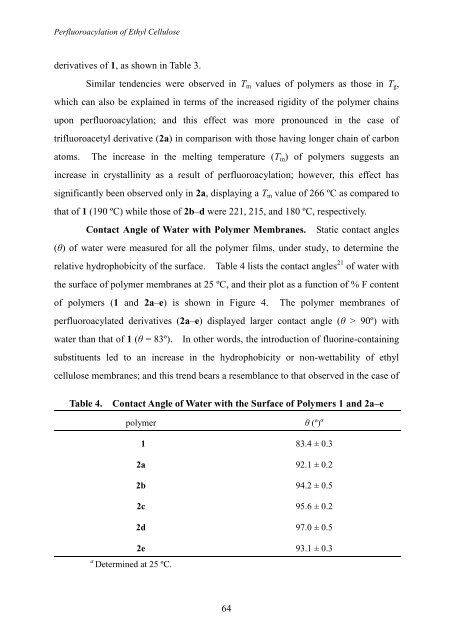Synthesis, Characterization, and Gas Permeation Properties
Synthesis, Characterization, and Gas Permeation Properties
Synthesis, Characterization, and Gas Permeation Properties
You also want an ePaper? Increase the reach of your titles
YUMPU automatically turns print PDFs into web optimized ePapers that Google loves.
Perfluoroacylation of Ethyl Cellulose<br />
derivatives of 1, as shown in Table 3.<br />
Similar tendencies were observed in Tm values of polymers as those in Tg,<br />
which can also be explained in terms of the increased rigidity of the polymer chains<br />
upon perfluoroacylation; <strong>and</strong> this effect was more pronounced in the case of<br />
trifluoroacetyl derivative (2a) in comparison with those having longer chain of carbon<br />
atoms. The increase in the melting temperature (Tm) of polymers suggests an<br />
increase in crystallinity as a result of perfluoroacylation; however, this effect has<br />
significantly been observed only in 2a, displaying a Tm value of 266 ºC as compared to<br />
that of 1 (190 ºC) while those of 2b–d were 221, 215, <strong>and</strong> 180 ºC, respectively.<br />
Contact Angle of Water with Polymer Membranes. Static contact angles<br />
(θ) of water were measured for all the polymer films, under study, to determine the<br />
relative hydrophobicity of the surface. Table 4 lists the contact angles 21 of water with<br />
the surface of polymer membranes at 25 ºC, <strong>and</strong> their plot as a function of % F content<br />
of polymers (1 <strong>and</strong> 2a–e) is shown in Figure 4. The polymer membranes of<br />
perfluoroacylated derivatives (2a–e) displayed larger contact angle (θ > 90º) with<br />
water than that of 1 (θ = 83º). In other words, the introduction of fluorine-containing<br />
substituents led to an increase in the hydrophobicity or non-wettability of ethyl<br />
cellulose membranes; <strong>and</strong> this trend bears a resemblance to that observed in the case of<br />
Table 4. Contact Angle of Water with the Surface of Polymers 1 <strong>and</strong> 2a–e<br />
polymer θ (º) a<br />
a Determined at 25 ºC.<br />
1 83.4 ± 0.3<br />
2a 92.1 ± 0.2<br />
2b 94.2 ± 0.5<br />
2c 95.6 ± 0.2<br />
2d 97.0 ± 0.5<br />
2e 93.1 ± 0.3<br />
64

















